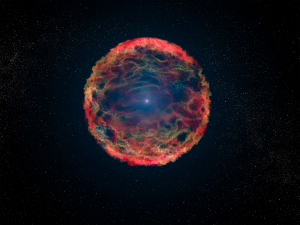
Artist’s impression of the star that would not die. Image credit: NASA, ESA, G. Bacon (STSci)
When a star explodes in a supernova, it’s generally assumed that once the afterglow has faded the star will never be seen again. But astronomers at Las Cumbres Observatory have found a star that seems to have refused to die. This month, Edward Gomez chats to colleague Dr. Iair Arcavi, who led the study of this unusual star.
Closer to home, we’ve had an interstellar visitor in the form of asteroid (or perhaps comet) 1I/2017 U1, or ‘Oumuamua to its friends. There was a new earth-sized planet discovered around the nearby Ross 128, and a ring of dust found around the Sun’s closest neighbour, Proxima Centauri. And, of course, how would we forget another pair of merging black holes discovered by the LIGO collaboration – this time the lightest yet.
For our take on all of these stories, have a listen to this week’s Pythagorean Astronomy.
An extended edition of an original broadcast on 29th November 2017 as part of Pythagoras’ Trousers on Radio Cardiff.
For an archive of Pythagorean Astronomy, visit pythagastro.uk.





